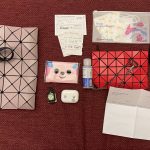The Story
(The below text in this “The Story” section were transcribed from my voice using an iPhone)
The story I am going to tell is one that my daughter Chloe asked me to record this is a story that she told me about a girl who never brushed her teeth once upon a time there was a little girl her name was Sarah Wendy Sarah found a packet of candy on the back of the package it send who ever eats this candy then she will be a rainbow on her tongue. So Sarah ate some candy and she went to look in the mirror and her tongue had turned rainbow colored. Sarah was so happy to see her tongue had turned into rainbow colors, and she never brushed her teeth again. She wanted to keep the rainbow colors on her tongue, so when she ate food she always used just the side of her mouth. Soon her mouth started to smell very bad, because all the bacteria are growing on her teeth. Her teeth were beginning to go black and rotten and her mom was very worried. Sarah‘s mom took her to see a dentist, and the dentist gave her some medicine and pulled out 10 of her teeth. The dentist said she had to take five days of medicine. After that Sarah brushed her teeth five times a day to make sure her teeth are nice and clean. Bye-bye guys thank you for reading the story see you next time. Bye
Analysis
I used my iPhone 12’s built-in Notes APP and keyboard to make the voice-to-text recording. In general, I think the built-in keyboard was very accurate in identifying what I was trying to say. Some common issues that were experienced were:
- Sentences did not end unless I verbally said the word ‘period’.
- Sometimes I remembered to say ‘period’, but it disrupted my train of thoughts and it was hard to make up the next sentence again. I consider the parts that didn’t have the correct punctuation marks to be mistaken because it makes it difficult for the readers to read, and it is grammatically incorrect.
- I could not express emotions in my story because there wasn’t enough reaction time for me to add in punctuations such as exclamation marks. This wasn’t really considered a mistake, but it just makes the story less expressive and exciting.
- Word recognition errors could not be fixed.
- Some pronunciation recognition errors included: ‘One day’ became the word ‘Wendy’, and ‘said’ became the word ‘send’.
- Some were actual mistakes made by me when thinking of what to say, but I wouldn’t just delete the sentence and start over. For example, “who ever eats this candy then she will be a rainbow on her tongue.”
If the alphabet had stayed 22 letters and only represented consonants, as it did in the Near East in 1700BCE (Healey, 1990), I think computer programmers would have a much harder time with creating the right codes to transcribe voice into text. Since the English language is written in a way that you can phonetically sound out the letters of the word, I think it also somehow makes it easier to understand potential transcribing errors. For example, each Chinese character is like a picture, if I had mispronounced a word, the characters presented would have completely different meanings and would render the sentence not understandable.
The text deviates from conventions of written English in that it doesn’t have the layout of a story such as a story title or line/paragraph breaks. Since writing is generally done more deliberately than speaking (Gnanadesikan, A. E., 2011), if I had scripted the story, I would have had more time to craft better and more descriptive sentences, which would help the readers visualize what was going on in the story. I would also put more effort into making the story more interesting by making sure I present problems and solutions to the storyline.
Oral storytelling is different from written storytelling because there’s less time to consider how to make it mistake-free or use better words. I felt a lot of pressure when recording my voice. I spoke very slowly to make sure that I am able to avoid sounds like ‘um’. In this way, the future of written text can no longer be assumed that the message is conveyed in a more precise way, because it may have just been transcribed via voice, which essentially, it’s just the spoken word in the text form.
It’s interesting that depending on the context that this story is to appear, the style of the writing would change. For example, if I was trying to tell a friend of this story over an instant messaging service, I would be more inclined to use emojis, or graphic symbols, which inventively combined punctuation marks to add emotional or intonational context to a writer’s text (Schmandt-Besserat, D., 2009).
References:
Gnanadesikan, A. E. (2011).“The First IT Revolution.” In The writing revolution: Cuneiform to the internetLinks to an external site. (Vol. 25). John Wiley & Sons (pp. 1-10).
Healey, J. (1990). The early alphabet. Berkeley: University of California Press.
Schmandt-Besserat, D. (2009). “Origins and Forms of Writing.” In Bazerman, C. (Ed.). Handbook of research on writing: History, society, school, individual, text.Links to an external site. New York, NY: Routledge.
